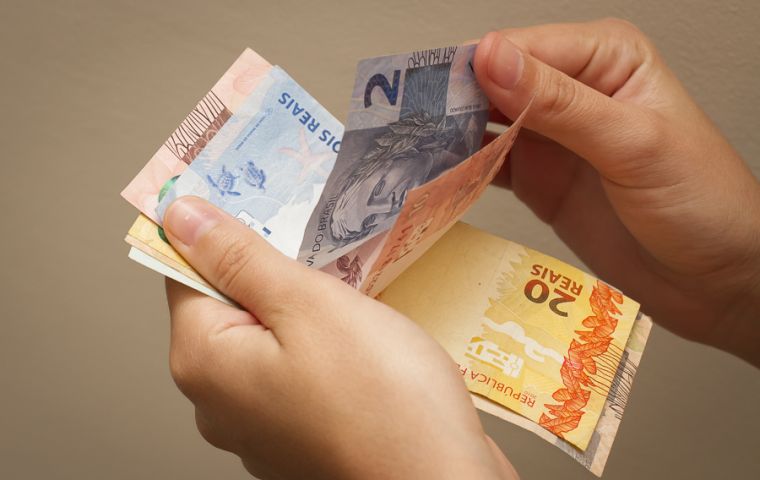MercoPress. South Atlantic News Agency
Brazil's inflation for March 2022 disclosed: highest in 28 years
 Consultants had estimated inflation for March would be between 0.54% to 1.43%, while all forecasts combined had yielded an average projection of 1.32%.
Consultants had estimated inflation for March would be between 0.54% to 1.43%, while all forecasts combined had yielded an average projection of 1.32%. Brazilian economic authorities have last week disclosed the monthly inflation for March of 2022: It was 1.62%, the highest for the same period in the last 28 years, making the year-on-year accumulation reach 11.30%, way above expectations.
Leading the new figures was the price of gasoline, which went up 6.95% in March for a 27.48% yoy jump. In 2021, official inflation was 10.06%, the highest in six years.
The National Wide Consumer Price Index (IPCA) had grown 1.01% in February, according to the Brazilian Institute of Geography and Statistics (IBGE). This year's 1.62% for March was the since 1994, before the Real Plan was implemented. It is also the highest monthly inflation since January 2003 (2.25%).
In the first quarter of 2022, inflation has accumulated 3.20% and an 11.30% increase yoy, “above the 10.54% observed in the immediately preceding 12 months,” said the IBGE. This is also the highest index for 12 months since October 2003 (13.98%).
It was Brazil's seventh month in a row with interannual inflation above two digits, which reinforces the likelihood of the basic interest rate (Selic) being raised in 2022 to more than 13% a year.
Projections from 41 financial institutions had forecast inflation for March would be between 0.54% to 1.43%, while all estimates combined had yielded an average increase of 1.32%.
Eight of the 9 groups of products and services surveyed by IBGE rose in March. The main impacts came from transport (3.02%) and food and beverages (2.42%). These two items combined make up for 43% of the month's inflation, while prices went up in 377 products and services surveyed by IBGE. The leading items were as follows - Food and beverages (2.42%), Housing (1.15%), Household goods (0.57%), Clothing (1.82%), Transport (3.02%), Health and personal care (0.88%), Personal expenses (0.59%), Education (0.15%), Communications: (-0,05%).
The hike was driven mainly by fuel prices, with gasoline accumulating a 27.48% yoy increase. There were also strong adjustments in cooking gas cylinders (6.57%), vehicle gas (5.29%), ethanol (3.02%), and diesel oil (13.65%), which has accumulated a 46.47% jump in 12 months. The increases reflect the 24.9% readjustment announced by Petrobras, which went into effect on March 11.
On the other hand, there was a drop in the price of airline tickets (-7.33%). It is important to note, however, that the IBGE methodology considers a trip booked two months in advance. “The variation reflects the price collection made in January for trips made in March,” explained the survey manager, Pedro Kislanov.
The increase in food and beverages was the highest since November 2020 (2.54%) and was due to certain items going up as much as 166.17% in 12 months, such as the case of carrots (31.47% in March), followed by tomatoes (27.22% last month).
The National Consumer Price Index (INPC), which calculates inflation for low-income families and is used as a reference for salary adjustments and INSS benefits, rose 1.71% in March, against 1% in February.
To bring inflation back to target, the Central Bank has been doing more monetary tightening. The basic interest rate (Selic) is currently at 11.75% and should continue to rise, reaching 12.75% in the next meeting of the Monetary Policy Committee (Copom) in May, according to Central Bank sources.
The prices of new cars (0.47%) and used cars (0.76%) also continued to rise, while - according to the National Association of Motor Vehicle Manufacturers (Anfavea), production grew 11.4% compared to February, reaching 184,800 units. But compared to March 2021, output was 7.8% lower. The accumulated production for the quarter also dropped when compared to the same period last year (-17%).
“Besides the semiconductor issue, we had negative impacts from the Omicron wave in the first two months of the year, due to its high contagion index, and a volume of rain and flooding above average, affecting the displacement of customers and the operation of several dealerships,” said the president of Anfavea, Luiz Carlos Moraes.
Vehicles exports fell 6.2% in March compared to February, with 38.9 thousand units exported, against 41.4 thousand in February. In the first quarter, the shipment of 108.1 thousand units represented an increase of 12.8% in exports. In the first quarter of last year, 95.8 thousand vehicles were sold abroad. Compared to March last year, there was a growth of 5.8%.




Top Comments
Disclaimer & comment rulesCommenting for this story is now closed.
If you have a Facebook account, become a fan and comment on our Facebook Page!